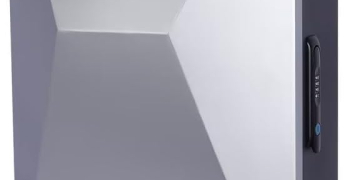2024-12-03 03:16:00
30fps.net
A little horizontal blur doesn’t hurt.
Previously in How to present
MS-DOS screenshots, I encouraged readers to take the original
pixel aspect ratio into account when showing pictures of old games.
There’s also a subtler issue to consider: the blur analog display
systems had.
In the context of modern pixel art games, video game historian and
preservationist Frank
Cifaldi proposes in a 2023 tweet
(screenshot) that one should do
vertical and horizontal scaling separately and differently:
Whole integer nearest neighbor scaling on the vertical axis, bilinear
scaling on horizontal. The slight blur is consistent with what a CRT
does and is not perceptible unless you glue your face to the screen.
In other words,
- first, vertical nearest neighbor integer scaling,
followed by - horizontal linear scaling.
So effectively this is the same as a nearest neighbor upscale
followed by a small horizontal blur. See the center pane below.

It’s a subtle difference. In the horizontally blurred case (center),
the dithering on the rocks is less pronounced and Jazz’s facial
expression is now easier to read. The pixel art crispiness is still
there, unlike in the blurry bilinear case.
See how the face reads differently when you’ve got some blur:

Seems like it works!
Who blurred it and why?
In the original tweet, Cifaldi’s reasoning was that the slight blur
is “consistent with what a CRT does.” My understanding is that this is
definitely true for most TVs, especially when connected to game consoles
via composite
video. So if you want your game to look like a 90’s console game,
his advice seems solid. Source is this
excellent 2023 blog post.
To give you an idea what composite video can look like at its worst,
here’s the same screenshot as above:

with a cheap capture card. I wrote a small program for the Nintendo 64
to output the image in a 640×576 mode without scaling.
Some people go as far as emulating
this look with shaders!
For PC monitors the situation is not as clear since they were of
higher quality and connected with VGA cables. VGA doesn’t exhibit
composite-like color smearing, because the colors don’t need to be
separated from the black & white signal with filters. Each of the
RGB components has its own wire.
The Jazz Jackrabbit 2 screenshot I used earlier is from a
1998 PC game, so it was experienced on a computer monitor not on a TV.
Is the slight horizontal blur still “period correct”? Assuming the CRT
was very high quality, blurring still can come from the graphics card or
a cheap VGA cable. Luckily this is something we can test!
VGA experiment
Let’s do an experiment to make the VGA signal horizontal blur
visible. I plugged my laptop to an LCD monitor with both HDMI and VGA
cables and compared the results. This basically simulates a high quality
CRT display and low quality VGA cable. I don’t expect the VGA output of
my old ThinkPad X240 to be exceptionally good either.
This is what I got.

I apologize for the exposure differences between photos. Still it
should be clear that the VGA image in the center is blurrier than the
digital HDMI image, but only horizontally.
Before taking the photos I configured the monitor for a pixel-perfect
image. I also set the “sharpness” value of the display settings so that
the picture was stable in a one-pixel-thin test pattern. The result on
the right shows what low “sharpness” looks like.
And here’s the same with more detail:

As a conclusion, I’d say the small horizontal blurring created by a
linear filter when scaling from 640×480 to 1280×960 is consistent with
the look of a mediocre VGA signal. In this case, the blur caused by VGA
was perhaps even slightly larger.
If you’re making your own pixel art game and showing it at 2x
magnification, the approach recommended in the tweet appears to be a
simple and effective choice. Assuming you want it to look retro, of
course 🙂
Larger magnification
Many MS-DOS games ran at a 320×200 resolution. This is an interesting
case because it’s “line doubled” to 320×400 by the graphics card. The
picture is effectively nearest neighbor scaled vertically in hardware
already, so the proposed method seems like a good fit.
Let’s try scaling up a screenshot of Cold
Dreams, a shareware game from 1995:

The results seem OK here as well. The value gradients on the
character are smoother, which perhaps makes it easier to see the
silhouette. The blur is probably larger than what a VGA cable alone
would cause, but it does look pretty nice!
More readings
The Jazz Jackrabbit 2 screenshot I took from the
Italian Wikipedia. The Cold Dreams image is from MobyGames. Thanks to the Bluesky
user Sonneveld for letting me know about this technique. Thanks to
everyone who participated in discussion after I presented earlier
results on Nov 23.
Keep your files stored safely and securely with the SanDisk 2TB Extreme Portable SSD. With over 69,505 ratings and an impressive 4.6 out of 5 stars, this product has been purchased over 8K+ times in the past month. At only $129.99, this Amazon’s Choice product is a must-have for secure file storage.
Help keep private content private with the included password protection featuring 256-bit AES hardware encryption. Order now for just $129.99 on Amazon!
Support Techcratic
If you find value in Techcratic’s insights and articles, consider supporting us with Bitcoin. Your support helps me, as a solo operator, continue delivering high-quality content while managing all the technical aspects, from server maintenance to blog writing, future updates, and improvements. Support Innovation! Thank you.
Bitcoin Address:
bc1qlszw7elx2qahjwvaryh0tkgg8y68enw30gpvge
Please verify this address before sending funds.
Bitcoin QR Code
Simply scan the QR code below to support Techcratic.

Please read the Privacy and Security Disclaimer on how Techcratic handles your support.
Disclaimer: As an Amazon Associate, Techcratic may earn from qualifying purchases.



































































![Roswell: The U.F.O. Cover-Up [DVD]](https://techcratic.com/wp-content/uploads/2025/07/91p97-50EwL._SL1500_-360x180.jpg)

![I Want to Believe 2: UFOs & UAPs [DVD]](https://techcratic.com/wp-content/uploads/2025/07/610qUN-KiL._SL1000_-360x180.jpg)









